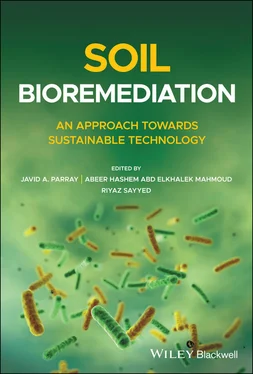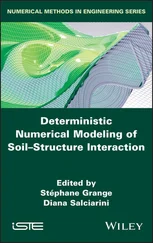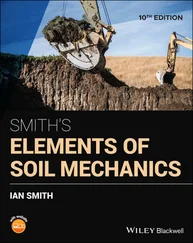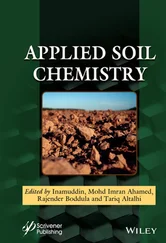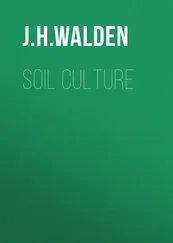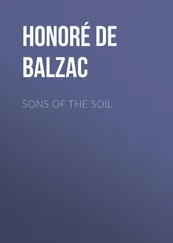1 Cover
2 Title Page Soil Bioremediation An Approach Towards Sustainable Technology Edited by Dr. Javid A. Parray Department of Environmental Sciences Govt Degree College Eidgah, Srinagar Jammu and Kashmir, India Dr. Abeer Hashem Abd Elkhalek Mahmoud Botany and Microbiology Department, College of Science King Saud University Riyadh, Saudi Arabia Mycology and Plant Disease Survey DepartmentPlant Pathology Research Institute Agriculture Research Center Giza, Egypt Prof. Riyaz Sayyed Department of Microbiology PSGVPM'S ASC CollegeShahada, India
3 Copyright Page
4 List of Contributors
5 Preface
6 1 In‐situ Bioremediation: An Eco‐sustainable Approach for the Decontamination of Polluted Sites 1.1 Introduction 1.2 Ex‐situ Versus In‐situ Bioremediation 1.3 In‐situ Bioremediation Techniques 1.4 Conclusion References
7 2 Bioremediation: A Green Solution to avoid Pollution of the Environment 2.1 Introduction 2.2 Sources of Heavy Metals 2.3 Impacts of Heavy Metals on Soil and Microbial Activity 2.4 Fate of Pesticides and Its Biodegradation in Soil 2.5 Strategies of Bioremediation 2.6 Adaptive Mechanism of Bioremediation for Heavy Metals, Pesticides, and Herbicides 2.7 Behavior of Inorganic and Organic Pollutants in Soil 2.8 Environmental Implications of Bioremediation 2.9 Conclusion References
8 3 Laccase: The Blue Copper Oxidase 3.1 What Is Laccase? 3.2 Distribution of Laccases 3.3 Application of Laccase 3.4 Conclusion References
9 4 Genome Assessment: Functional Gene Identification Involved in Heavy Metal Tolerance and Detoxification 4.1 Introduction 4.2 Tolerance and Degradation Mechanisms of Toxic Metals by Microorganisms 4.3 Genetic Engineering in Bioremediation Processes for Some Major Elements 4.4 Biotechnological Intervention for Some Important Heavy Metals 4.5 Future Perspective 4.6 Conclusions References
10 5 Bioremediation of Heavy Metal Ions Contaminated Soil 5.1 Introduction 5.2 Bioremediation 5.3 Phytoremediation 5.4 Analytical Methods in Bioremediation of Metals 5.5 Conclusion References
11 6 Bioremediation of Dye Contaminated Soil 6.1 Introduction 6.2 History and Usage of Dyes 6.3 Classification of Dyes 6.4 Problems Due to Colored Textile Effluent 6.5 Physico‐Chemical Quality of Textile Effluents 6.6 Dye Decolorization/Degradation Techniques 6.7 Factors that Control the Discoloration of Microbial Dye 6.8 Conclusions References
12 7 Composting and Bioremediation Potential of Thermophiles 7.1 Introduction 7.2 Heavy Metal Resistance Genes 7.3 Biotransformation‐Based Bioremediation 7.4 Future Perspectives Acknowledgments References
13 8 Ecological Perspectives of Halophilic Fungi and their Role in Bioremediation 8.1 Introduction 8.2 Hypersaline Inhabitant Fungi 8.3 Strategies Against the Hypersaline Environment 8.4 Ecological Perspectives of Hypersaline Fungi 8.5 Conclusions References
14 9 Rhizobacteria‐Mediated Bioremediation: Insights and Future Perspectives 9.1 Introduction 9.2 Bioremediation: Rescue Plan by Natural Agents 9.3 Rhizoremediation 9.4 Rhizospheric Microbial Community 9.5 Practices that Improves Rhizoremediation 9.6 Future Perspective 9.7 Advantages of Rhizoremediation 9.8 Conclusion Acknowledgment References
15 10 Bioremediation Potential of Rhizobacteria associated with Plants Under Abiotic Metal Stress 10.1 Introduction 10.2 Mode of Action Rhizobacteria 10.3 Bioremediation 10.4 Genetically Modified Plant‐Associated Microbes for Heavy Metal Stress Tolerance 10.5 Highly Toxic Metals 10.6 Effects of Highly Toxic Metals on Plant Growth 10.7 Conclusion References
16 11 Molecular and Enzymatic Mechanism Pathways of Degradation of Pesticides Pollutants 11.1 Introduction 11.2 Effect of Pesticides on Soil Enzymes 11.3 Introduction of Plasmids in Soil Bacteria 11.4 Microbial Degradation of Pesticides 11.5 Enzymatic Degradation 11.6 Organophosphorus Hydrolase and Organophosphorus Dehydrogenase (OPH and OPD) 11.7 Pesticide–Antibiotic Cross Resistance 11.8 Conclusions Acknowledgments References
17 12 Bioremediation of Heavy Metals and Other Toxic Substances by Microorganisms 12.1 Introduction 12.2 Sources of Heavy Metals 12.3 Effects of Heavy Metals on Plant, Microorganisms, and Human Health 12.4 Current Approaches for Remediation of Heavy Metals 12.5 Mechanisms Involved in Bioremediation 12.6 Types of Bioremediation 12.7 Strategies of Bioremediation 12.8 Factors Affecting Bioremediation 12.9 Pros and Cons of Applicability of Bioremediation Approaches Under Field Conditions 12.10 Conclusion and Future Prospects References
18 13 Trends in Heavy Metal Remediation: An Environmental Perspective 13.1 Introduction 13.2 Sources of Heavy Metals 13.3 Heavy Metal Impacts 13.4 Current Scenario of Heavy Metals 13.5 Microorganisms and Remediation of Heavy Metals 13.6 Mechanism of Metal Tolerance by Resistant Species 13.7 Conclusion References
19 Index
20 End User License Agreement
1 Chapter 1 Table 1.1 Various aspects affecting in‐situ bioremediation.
2 Chapter 2 Table 2.1 Effect of different heavy metals on plants and humans.
3 Chapter 4 Table 4.1 Information related to some of the toxic heavy metals and their res... Table 4.2 Identification of functional genes involved in tolerance and detoxi...Table 4.3 Summary of process, removal, and resistance to different heavy meta...
4 Chapter 6Table 6.1 Microbial dye decolorization mechanisms under varied culture condit...
5 Chapter 7Table 7.1 Metal resistance genes detected in thermophilic bacteria and archae...
6 Chapter 9Table 9.1 List of different microbes and host crops/plants evaluated for reme...
7 Chapter 10Table 10.1 Bioremediation of heavy metal by rhizobacterial strains associated...Table 10.2 List of genetically modified plant‐associated microbes for heavy m...
8 Chapter 12Table 12.1 Physical, chemical, and biological remediation techniques for the ...Table 12.2 Microorganisms involved in sorption and accumulation of heavy meta...
9 Chapter 13Table 13.1 Heavy metal accumulating microorganisms and mechanisms of resistan...Table 13.2 List of genetically engineered bacteria that have been used for re...
1 Chapter 3 Figure 3.1 Oxidation of substrate with laccase enzyme. Figure 3.2 Applications of laccase.
2 Chapter 5Figure 5.1 The numbers of articles published since 1995 (according to the We...
3 Chapter 6Figure 6.1 Strategies for treatment of textile dyes from contaminated sites....Figure 6.2 Mechanism of dye decolorization and degradation.
4 Chapter 9Figure 9.1 Rhizospheric microorganism link between plant and soil.Figure 9.2 Plant growth promoting activities of rhizobacteria.Figure 9.3 A graphical representation of microbe‐mediated rhizoremediation a...
5 Chapter 11Figure 11.1 Monocrotophos biodegradative pathways [142].Figure 11.2 Bioaccumulation of pesticide.
6 Chapter 12Figure 12.1 Physical, chemical, and biological methods of remediation of hea...
7 Chapter 13Figure 13.1 Various metabolic processes that are inhibited due to metal toxi...
1 Cover Page
2 Title Page Soil Bioremediation An Approach Towards Sustainable Technology Edited by Dr. Javid A. Parray Department of Environmental Sciences Govt Degree College Eidgah, Srinagar Jammu and Kashmir, India Dr. Abeer Hashem Abd Elkhalek Mahmoud Botany and Microbiology Department, College of Science King Saud University Riyadh, Saudi Arabia Mycology and Plant Disease Survey DepartmentPlant Pathology Research Institute Agriculture Research Center Giza, Egypt Prof. Riyaz Sayyed Department of Microbiology PSGVPM'S ASC CollegeShahada, India
3 Copyright Page
4 List of Contributors
Читать дальше
